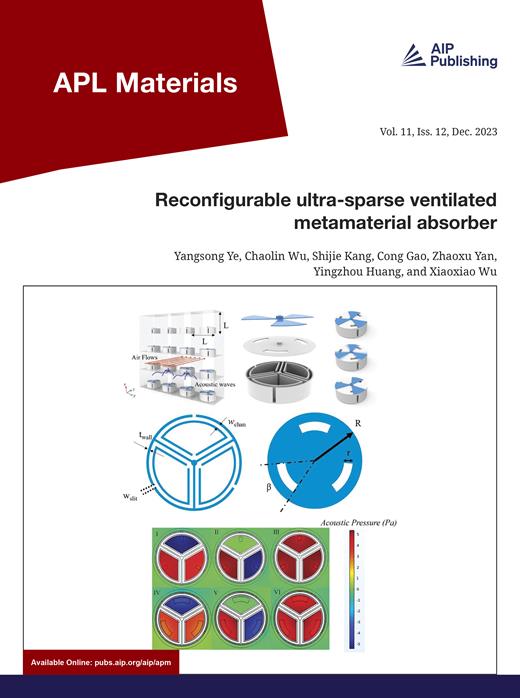A low-cost and convenient route of fabricating GaN films with P-type mixed microcrystalline and amorphous structure deposited via Ga target of magnetron sputtering
IF 5.3
2区 材料科学
Q2 MATERIALS SCIENCE, MULTIDISCIPLINARY
引用次数: 0
Abstract
GaN, a third-generation semiconductor, has gained widespread attention owing to its high temperature resistance, wide bandgap, and high critical breakdown electric fields. Magnetron sputtering has a broad potential in the field of low-cost growth of GaN on account of high efficiency, superior quality, and convenient operation. However, challenges caused from the pure Ga targets with a huge refrigeration system need to be resolved for wide practices. Here, a new and cost-effective Ga target for magnetron sputtering was fabricated by utilizing the wetting properties of CuGa2 and Ga. Mixed microcrystalline and amorphous GaN films were obtained via reactive magnetron sputtering employing the Ga target. The average deposition rate is about 1.68 nm/min, and the average roughness is ∼7.45 ± 0.26 nm under 100 W of sputtering power. In addition, the sputtered GaN films were found to be wide-bandgap and p-type semiconductors with high transmittance, as revealed by x-ray photoelectron spectroscopy and absorption spectra. The GaN films display a bandgap of ∼3.60 eV and a transmittance exceeding 88.5% in the visible range. Furthermore, field-effect transistors and metal–semiconductor–metal photodetectors have been fabricated using the obtained GaN films, demonstrating favorable response characteristics. The prospects of microcrystalline/amorphous GaN films in sensing, power devices, and flexible electronics were forecasted. Overall, a low-cost and pervasive route of target fabrication process expands the possibilities of using low melting point metals in magnetron sputtering.通过磁控溅射镓靶沉积具有 P 型微晶和非晶混合结构的氮化镓薄膜的低成本便捷制备路线
氮化镓是第三代半导体,因其耐高温、宽带隙和高临界击穿电场而受到广泛关注。磁控溅射具有效率高、质量好、操作方便等优点,在低成本生长氮化镓领域具有广阔的发展前景。然而,为了广泛应用,需要解决纯镓靶材与庞大的制冷系统所带来的挑战。在此,我们利用 CuGa2 和 Ga 的润湿特性,制造了一种新型且经济高效的磁控溅射 Ga 靶件。利用这种镓靶,通过反应磁控溅射获得了微晶和非晶氮化镓混合薄膜。在 100 W 溅射功率下,平均沉积速率约为 1.68 nm/min,平均粗糙度为 ∼7.45 ± 0.26 nm。此外,X 射线光电子能谱和吸收光谱显示,溅射出的氮化镓薄膜是具有高透过率的宽带隙 p 型半导体。氮化镓薄膜的带隙为∼3.60 eV,在可见光范围内的透过率超过 88.5%。此外,利用所获得的氮化镓薄膜制作的场效应晶体管和金属-半导体-金属光电探测器也显示出良好的响应特性。研究人员还预测了微晶/非晶氮化镓薄膜在传感、功率器件和柔性电子器件中的应用前景。总之,低成本和普遍的靶材制造工艺路线拓展了在磁控溅射中使用低熔点金属的可能性。
本文章由计算机程序翻译,如有差异,请以英文原文为准。
求助全文
约1分钟内获得全文
求助全文
来源期刊

APL Materials
NANOSCIENCE & NANOTECHNOLOGYMATERIALS SCIE-MATERIALS SCIENCE, MULTIDISCIPLINARY
CiteScore
9.60
自引率
3.30%
发文量
199
审稿时长
2 months
期刊介绍:
APL Materials features original, experimental research on significant topical issues within the field of materials science. In order to highlight research at the forefront of materials science, emphasis is given to the quality and timeliness of the work. The journal considers theory or calculation when the work is particularly timely and relevant to applications.
In addition to regular articles, the journal also publishes Special Topics, which report on cutting-edge areas in materials science, such as Perovskite Solar Cells, 2D Materials, and Beyond Lithium Ion Batteries.
 求助内容:
求助内容: 应助结果提醒方式:
应助结果提醒方式:


